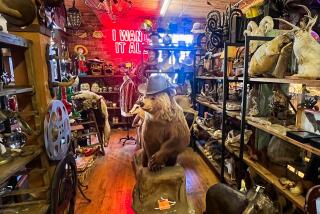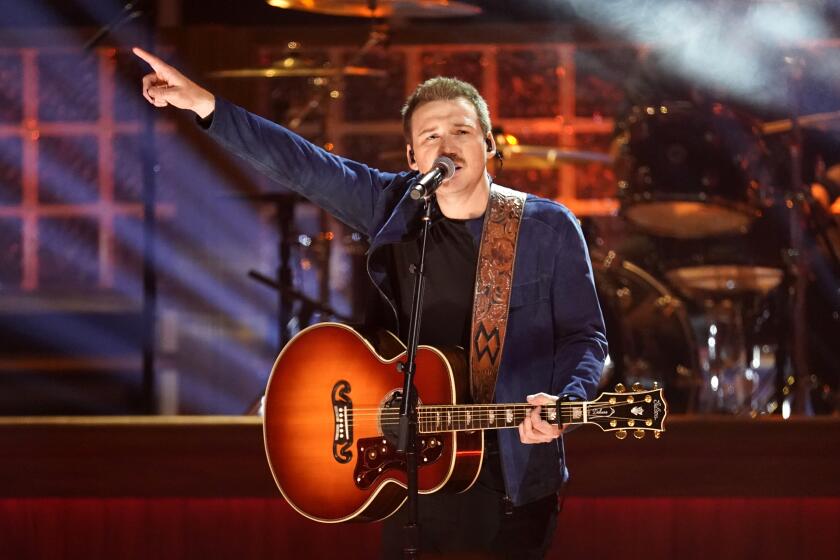Filmgoers’ enduring love for B-movies
B-movies, those low-budget, low-prestige genre films that were fan favorites for decades, have an enduring place in Hollywood history.
Some of the screen’s greatest actors and directors cut their teeth on B-westerns (John Wayne, for example) or B-horror flicks (director Robert Wise among many others. And B-movie serials such as “Flash Gordon” or films such as “Cat People” and “I Walked With a Zombie” from the 1940s were a major influence on such filmmakers as George Lucas and Martin Scorsese.
“These B-features were shorter in time, lower in budget,” said film noir historian Alan Rode. “To me, a B-movie is something that is fast, it moves and is entertaining first and foremost.”
Perhaps no modern director owes more to the B-movie aesthetic than Quentin Tarantino. His new Oscar-nominated film “Django Unchained” is done in the style of the so-called spaghetti westerns of the 1960s and ‘70s. Many of Tarantino’s films pay homage to that era of filmmaking when the traditional B”-movie morphed into the exploitation flicks shown at drive-ins and cheap cinemas.
OSCAR WATCH: ‘Django Unchained”
“You get a lot more exploitation and nudity when the parameters of internal censorship were no longer at work,” said Jan-Christopher Horak, head of the UCLA Film & Television Archive.
In fact, when Tarantino made the 1997 crime thriller “Jackie Brown,” based on Elmore Leonard’s “Rum Punch,” he changed the race of the heroine from white to black so he could work with Pam Grier, who came to fame in the 1970s in blaxploitation films such as 1974’s “Foxy Brown.”
Director Joe Dante (“Gremlin”) believes that Tarantino continues to make the kind of movie he saw when he was younger.
“He is a video store guy,” notes Dante, who began his career making films for B-movie mogul Roger Corman. “He had access to all of these bizarre films, many of which were made overseas that weren’t theatrically released here.”
“Django Unchained” was inspired by a series of vintage Italian spaghetti westerns, most notably the Sergio Leone-Clint Eastwood Dollars trilogy. Those movies’ themes of violent revenge, along with a dark sense of humor, can clearly be seen in “Django” and other films.
The glory years
B-movies flourished from the 1920s through the late 1940s, when the studios owned their own theaters and booked double bills of a big-budget, star-driven A-feature and a less-expensive B-film.
Westerns starring Roy Rogers, Hoot Gibson and Gene Autry were B-movies as were 1940s Universal horror films such as “The Ghost of Frankenstein.” Other notable B-film series included Universal’s Ma and Pa Kettle and Sherlock Holmes, Fox’s Charlie Chan mysteries and Monogram’s Bowery Boys comedies.
Several Poverty Row studios such as Monogram made only B-movies, while the major studios had specific B-movie units.
Sometimes B-movies featured talent on their way down, but more often they were a testing ground for up-and-comers such as Wise, Richard Fleischer, Edward Dmytryk, Fred Zinnemann, Anthony Mann and Budd Boetticher. But some directors were content to stay in B-pictures because there was little interference from the front office. One example: Edgar G. Ulmer, best known for his cult 1945 film noir “Detour.”
The vintage B-movie began to wane when the studios lost control of their theaters in the late 1940s. Though studios such as Universal made horror and sci-fiction films in the 1950s, a lot of the B-movie product eventually was transformed into TV series.
The genre enjoyed something of a revival with the rise of drive-ins in the 1950s and the demise of the production code in the late 1960s. Producers such as Sam Arkoff and Corman of American International Pictures made their own low-budget double bills.
Several of cinemas most accomplished directors got their start in exploitation B-movies.
At AIP and later at his own New World Pictures, Corman gave several famous directors their breaks, including such Oscar winners as Scorsese, Francis Ford Coppola and Ron Howard.
“You gave him the exploitation elements that he needed to sell the movie, and as long as the picture was in focus and the shots weren’t upside down, he would pretty much give you creative freedom,” Dante recalled of his Corman years.
“I think a lot of people were spooked when they went to the studio system and discovered how many people were looking over your shoulder. It’s kind of a rude awakening.”
PHOTOS AND MORE
VIDEO: The making of ‘Argo,’ ‘Les Miz’ and more
ENVELOPE: The latest awards buzz
PHOTOS: NC-17 movies: Ratings explained
More to Read
The biggest entertainment stories
Get our big stories about Hollywood, film, television, music, arts, culture and more right in your inbox as soon as they publish.
You may occasionally receive promotional content from the Los Angeles Times.







